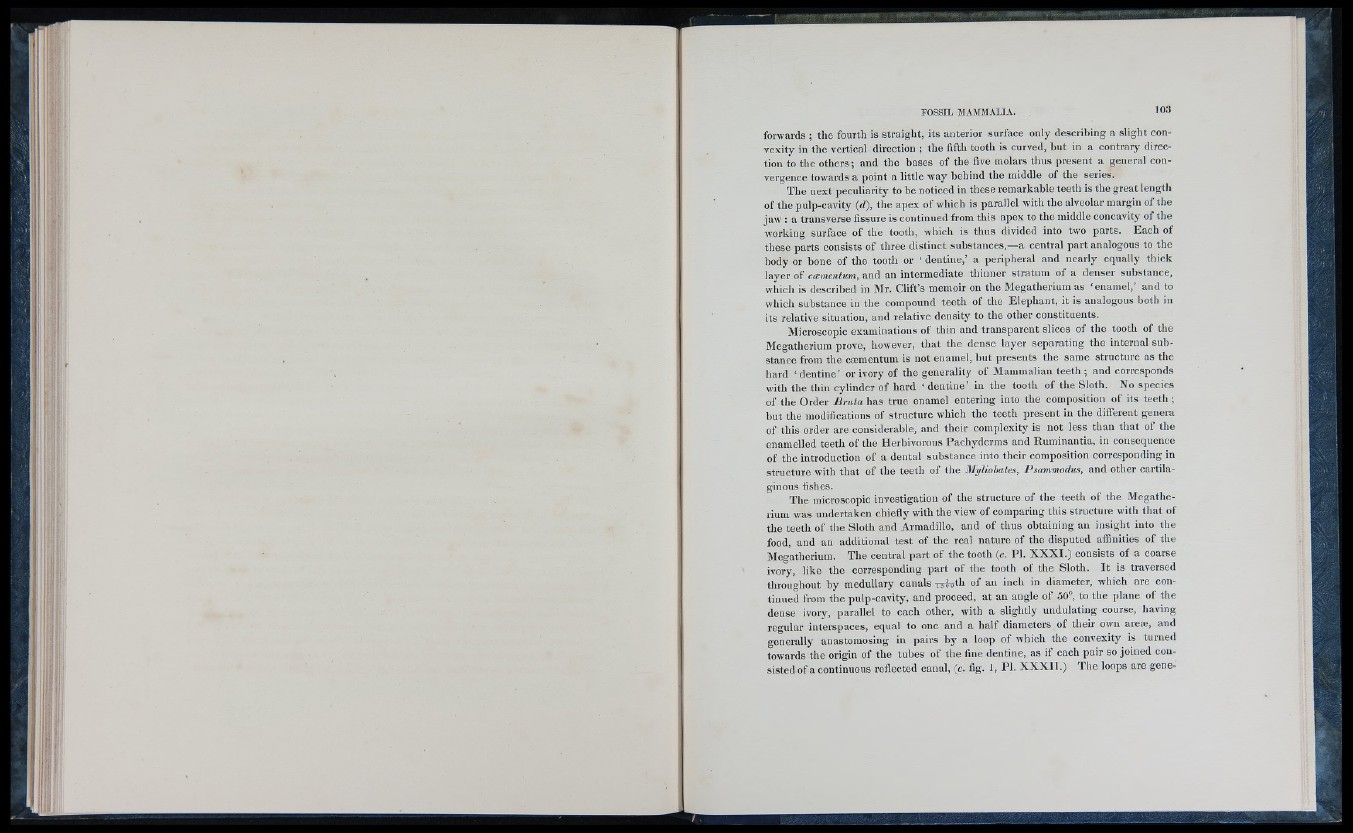
forwards ; the fourth is straight, its anterior surface only describing a slight conv
ex ity in the vertical direction ; the fifth tooth is curved, but in a contrary direction
to the others ; and the bases o f the five molars thus present a general convergence
towards a point a little way behind the middle o f the series.
The next peculiarity to be noticed in these remarkable teeth is the great length
o f the pulp-cavity (rf), the apex o f which is parallel with the alveolar margin o f the
jaw : a transverse fissure is continued from this apex to the middle concavity o f the
working surface o f the tooth, which is thus divided into two parts. Each o f
these parts consists o f three distinct substances,—-a central part analogous to the
body or bone o f the tooth or ‘ dentine,’ a peripheral and nearly equally thick
layer o f cæmentum, and an intermediate thinner stratum o f a denser substance,
which is described in Mr. Clift’s memoir on the Megatherium as ‘enamel,’ and to
which substance in the compound teeth of the Elephant, it is analogous both in
its relative situation, and relative density to the other constituents.
Microscopic examinations o f thin and transparent slic e s o f the tooth o f the
Megatherium prove, however, that the dense layer separating the internal substance
from the cæmentum is not enamel, but presents the same structure as the
hard ‘ dentine’ or ivory o f the generality o f Mammalian teeth ; and corresponds
with the thin cylinder o f hard ‘ d en tin e ’ in the tooth o f the Sloth. No spe cie s
o f the Order B ru ta has true enamel entering into the composition o f its teeth ;
but the modifications o f structure which the teeth present in the different genera
o f this order are considerable, and their complexity is not le ss than that of the
enamelled teeth o f the Herbivorous Pachyderms and Ruminantia, in consequence
o f the introduction o f a dental substance into their composition corresponding in
structure with that o f the teeth o f the Alyliohates, Psammodus, and other cartilaginous
fishes.
The microscopic investigation o f the structure o f the teeth o f the Megatherium
was undertaken chiefly with the view o f comparing this structure with that o f
the teeth o f the Sloth and Armadillo, and o f thus obtaining an insight into the
food, and an additional test of the real nature o f the disputed affinities o f the
Megatherium. The central part o f the tooth (c. PI. X X X I .) consists of a coarse
ivory, like the corresponding part o f the tooth o f the Sloth. I t is traversed
throughout by medullary canals Trlvth of an inch in diameter, which are continued
from the pulp-cavity, and proceed, at an angle o f 50°, to the plane o f the
dense ivory, parallel to each other, with a slightly undulating course, having
regular interspaces, equal to one and a ha lf diameters o f their own areæ, and
generally anastomosing in pairs b y a loop o f whicli the convexity is turned
towards the origin o f the tubes o f the fine dentine, as if each pair so joined consisted
o fa continuous reflected canal, (c. fig. 1, PI. X X X I I .) Th e loops are gene